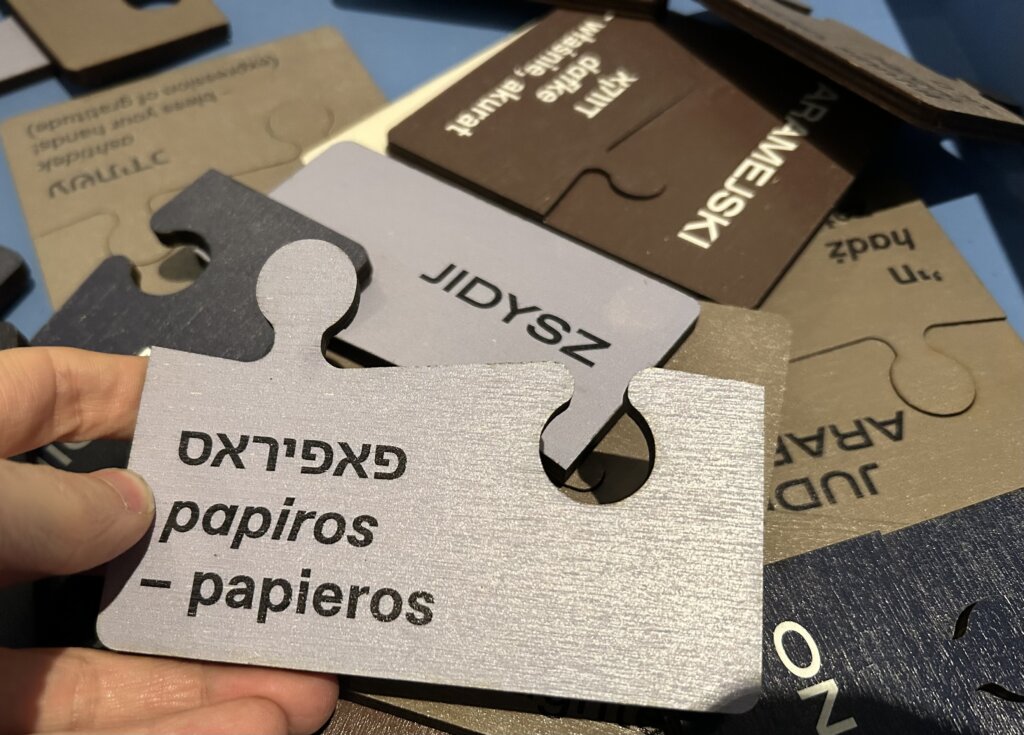Uncategorized
An exhibit at Warsaw’s Polin Museum on the history of Jewish languages

אין אַ נײַער אויסשטעלונג בײַם ייִדישן מוזיי „פּולין“ זעט מען, אַז עספּעראַנטאָ איז אויך אַ ייִדישע שפּראַך.
די סיבה דערפֿאַר איז נישט בלויז ווײַל דער פֿאַרטראַכטער פֿון עספּעראַנטאָ, ד״ר לייזער זאַמענהאָף, איז געווען אַ ייִד, אַ געבוירענער אין ביאַליסטאָק. אין די ערשטע יאָרן זענען אַ סך רעדערס פֿון עספּעראַנטאָ געווען ייִדן, ווײַל זיי האָבן געליטן פֿון אַנטיסעמיטיזם און האָבן געחלומט פֿון אַ וועלט אָן נאַציאָנאַלע און רעליגיעזע גרענעצן. דער ייִדישיסט און עספּעראַנטיסט, ד״ר צבֿי סדן, האָט טאַקע אַ מאָל באַמערקט: „עספּעראַנטאָ איז ייִדיש פֿאַר גויים“.
פֿון דעסט וועגן, איז די צענטראַלע שפּראַך בײַ ייִדן אין משך פֿון דער גאַנצער געשיכטע אַוודאי העברעיִש, און דער פֿאַקט ווערט נישט פֿאַרשוויגן אין דער נײַער אויסשטעלונג. זי הייבט זיך אָן מיטן אַלטן העברעיִש אין די אויפֿשריפֿטן אין „כּתבֿ עבֿרי“, די אַלטע אותיות, וואָס ייִדן האָבן געניצט אין דער צײַט פֿון די מלכים, פֿאַרן גלות בבֿל.
דערנאָך האָבן זיי אָנגעהויבן אַריבערגיין צום „כּתבֿ אַשורית“, די אַסירישע אותיות — דאָס וואָס מיר רופֿן הײַנט „העברעיִשע אותיות“. די אויסשטעלונג לאָזט זיך אויס מיטן מאָדערנעם העברעיִש, עבֿריתּ, וואָס דער ליטוואַק אליעזר יצחק פּערלמאַן האָט געהאָלפֿן צו באַנײַען און אויפֿצולעבן סוף 19טן י״ה. יענער פּערלמאַן איז אונדז באַקאַנט מיטן נאָמען אליעזר בן־יהודה.
אין משך פֿון אַן ערך 2,500 יאָר צווישן דער תּקופֿה פֿונעם „כּתבֿ עבֿרי“ און דעם הײַנטיקן עבֿריתּ האָבן זיך ייִדן באַניצט מיט אַ סך אַנדערע שפּראַכן — אַזוי פֿיל, אַז מע קען זיי אַפֿילו נישט אויפֿציילן. עטלעכע קען מען באַטראַכטן ווי אמתע ייִדישע שפּראַכן, ד״ה אַזעלכע, וואָס ייִדן האָבן זיי פֿאַרהיימישט און פֿאַרייִדישט, אַפֿילו ווען זיי זענען לכתּחילה געווען וואַריאַנטן פֿון גוייִשע שפּראַכן.
די ערשטע שפּראַך אַזאַ איז געווען אַראַמיש, וואָס אויף איר זענען געשריבן גרויסע טיילן פֿון ספֿר דניאל און ספֿר עזרה, ,ווי אויך דער גרעסטער טייל פֿונעם תּלמוד. כאָטש מיר רופֿן די שפּראַך פּשוט „אַראַמיש“, איז זי באמת ייִדיש־אַראַמיש, ווײַל אַ סך אַנדערע פֿעלקער האָבן אויך גערעדט פֿאַרשידענע סאָרטן אַראַמיש — גוייִש־אַראַמיש — ביזן הײַנטיקן טאָג.
דאָס דריטע רינגל אין דער קייט פֿון ייִדישע לשונות איז ייִדיש־גריכיש, וואָס איז אויפֿגעקומען נאָך דעם ווי אַלכּסנדר מוקדון האָט אײַנגענומען די ריזיקע פּערסישע אימפּעריע, אַרײַנגערעכנט ארץ־ישׂראל. אַ סך ייִדן זענען געווען צוגעצויגן צו דער גריכישער שפּראַך און קולטור, ווי מיר ווייסן פֿונעם יום־טובֿ חנוכּה. פֿאַרשידענע סאָרטן ייִדיש־גריכיש האָט מען גערעדט אין משך פֿון איבער צוויי טויזנט יאָר, ביז נישט לאַנג צוריק. ליידער האָבן די נאַציס און זייערע מיטהעלפֿערס אויסגעהרגעט אַ סך פֿון די לעצטע רעדערס פֿון ייִדיש־גריכיש, וואָס מע רופֿט זיי די ראָמאַניאָטעס. די פֿאַרבליבענע ראָמאַניאָטישע ייִשובֿים אין גריכנלאַנד רעדן הײַנט שוין דאָס גוייִשע גריכיש, ווי זייערע שכנים.
ווען די רוימער האָבן אײַנגענומען אַלע לענדער אַרום דעם מיטלענדישן ים, האָבן די ייִדן אויך אָנגעהויבן רעדן לאַטײַן, לכל־הפּחות אין דער מערבֿדיקער העלפֿט פֿון דער אימפּעריע. (אין מיזרח האָט מען ווײַטער גערעדט גריכיש.) לאַטײַן האָט זיך מיט דער צײַט פֿאַרוואַנדלט אין די הײַנטיקע ראָמאַנישע שפּראַכן: איטאַליעניש, שפּאַניש, פֿראַצויזיש אאַז״וו.
יעדע ראָמאַנישע שפּראַך האָט געהאַט אַ ייִדישן וואַריאַנט. נאָכן גירוש ספֿרד למשל האָבן אַ סך שפּאַנישע ייִדן זיך באַזעצט אין דער אָטאָמאַנישער אימפּעריע, האָט זייער ייִדיש־שפּאַניש (וואָס מע רופֿט הײַנט לאַדינאָ) אַרײַנגענומען אַ סך ווערטער פֿון די אָרטיקע לשונות: פֿון טערקיש, אַראַביש, אויך פֿון די באַלקאַנישע שפּראַכן.
די אויסשטעלונג דערציילט נישט צו פֿיל וועגן דער געשיכטע פֿון ייִדיש, אָבער אינעם קאָנטעקסט פֿונעם גאַנצן „פּולין“־מוזיי איז דאָס נישט קיין עוולה. די פּערמאַנענטע אויסשטעלונג האָט זייער אַ סך וועגן ייִדיש און וועגן דער קולטור אויף ייִדיש. עטלעכע אַמעריקאַנער פֿאָרשערס, גוטע ייִדיש־קענערס, אַזוי ווי ברײַנדל קירשנבלאַט־גימבלעט און שמואל קאַסאָוו, האָבן געדינט דעם מוזיי ווי עצה־געבערס, און אפֿשר דערפֿאַר איז דאָ אַ סך מער ייִדיש אין „פּולין“־מוזיי ווי אין אַנדערע ייִדישע מוזייען אויף דער וועלט. (הלוואַי וואָלט געווען אַזאַ מוזיי אין ניו־יאָרק אָדער תּל־אָבֿיבֿ!)

אָבער די קוראַטאָרן פֿון דער אויסשטעלונג האָבן געהאַט אַ פּראָבלעם: דער דורכשניטלעכער פּוילישער באַזוכער קען נישט לייענען די העברעיִשע אותיות. אַפֿילו די ייִדישע באַזוכער און די געסט פֿון אויסלאַנד זענען מסתּמא קנאַפּע קענערס פֿון ייִדיש־גריכיש און ייִדיש־פּערסיש, למשל. איז נישט קיין חידוש, וואָס מע האָט דאָ געלייגט דעם טראָפּ אויף די שיינע עקספּאָנאַטן און נישט אויף די שפּראַכן גופֿא. מע ווײַזט אַ סך אַלטע חפֿצים, ספֿרי־תּורות, כּתבֿ־ידן, קמיות, פּרעכטיקע אילומינאַציעס. אפֿילו קינדערלעך, וואָס קענען נישט קיין צורת־אות, קענען הנאה האָבן פֿון אַזאַ שיינקייט.
דער אינטערעסאַנטסטער טייל פֿון דער אויסשטעלונג איז, לויט מיר, ווען מע קען הערן עטלעכע פֿון די ייִדישע שפּראַכן. מע האָט הײַנט זעלטן אַ געלעגנהייט צו הערן ייִדיש־גריכיש אָדער ייִדיש־איטאַליעניש, אָדער אַפֿילו לאַדינאָ. ס׳איז טשיקאַווע צו הערן, ווי די שפּראַך קלינגט, און צו פּרובירן אַ ביסל צו פֿאַרשטיין. אַ סך פּוילישע סטודענטן פֿון ייִדיש וועלן דערקענען דאָס קול, וואָס רעדט דאָרט ייִדיש, ווײַל עס איז עטל ניבאָרסקי, וואָס איז עטלעכע מאָל געקומען קיין פּוילן, כּדי צו לערנען אין דער וואַרשעווער זומער־פּראָגראַם. נאָך בעסער וואָלט געווען, ווען מע ווײַזט אויפֿן עקראַן דעם טעקסט פֿון די ווערטער וואָס מע רעדט, ווײַל אַזוי וואָלט מען געקענט פֿאַרשטיין אַ ביסל בעסער.
אויך זייער געראָטן זענען די שפּילערײַען אין דער אויסשטעלונג, וואָס זענען נישט בלויז פֿאַר קינדער. עס זענען דאָ שטיקלעך פֿון אַ רעטעניש (פּאָזל) מיט פֿאַרשידענע ווערטער, וואָס מע דאַרף זיי צונויפֿפּאָרן מיט אַנדערע שטיקלעך מיטן נאָמען פֿון דער שפּראַך. מע קען דאָרט אַנטדעקן, למשל, אַז דאָס וואָרט „פּופּיק“ קומט פֿון טשעכיש, און אַז דאָס וואָרט „דברארה“ (dabberare) מיינט „רעדן“ אויף ייִדיש־איטאַליעניש.

די אויסשטעלונג איז דער עיקר אַ קינסטלערישע און אַ היסטאָרישע, נישט קיין לינגוויסטישע. פֿון דעסט וועגן, פֿעלט דאָרט אַ ביסל דער הײַנטיקער מצבֿ. מיר ווייסן דאָך, אַז הײַנט רעדט מען נישט קיין ייִדיש־איטאַליעניש אָדער ייִדיש־גריכיש און אַ סך פֿון די אַנדערע אַמאָליקע ייִדישע שפּראַכן. אונדזער ייִדיש האָט דווקא גרויס מזל, וואָס די חסידים האָבן זיך אָנגעכאַפּט אין איר און רעדן זי מיט זייערע קינדער. אַנדערש וואָלט דער מצבֿ טאַקע געווען ביטער.
אָבער הײַנט רעדן ייִדן, דער עיקר, עבֿריתּ, אויב זיי וווינען אין מדינת־ישׂראל, אָדער ענגליש, אויב זיי וווינען אין די תּפֿוצות. עטלעכע הונדערט טויזנט רעדן פֿראַנצויזיש, רוסיש און שפּאַניש. דאָס הייסט, דווקא די שפּראַכן, וואָס ייִדן רעדן הײַנט פֿעלן אין דער אויסשטעלונג.
ס’איז אמת, אַז ייִדיש־ענגליש און ייִדיש־שפּאַניש, למשל, זענען באמת נישט קיין שפּראַכן פֿאַר זיך. מיט אַנדערע ווערטער, אַז מע וווינט אין אַ ייִדישער סבֿיבֿה, קען מען אַרײַנוואַרפֿן ווערטער און קאָנסטרוקציעס פֿון העברעיִש אָדער ייִדיש. די פֿאָרשערין פֿון ייִדישע שפּראַכן, שׂרה בענאָר, רופֿט דאָס אַ ייִדישער „רעפּערטואַר“, וואָס ייִדן קענען ניצן, ווען זיי ווילן.
אַז אַ ייִד זאָגט למשל: Good Shabbos! The seudah will be by me. See you in shul קען מען בולט זען די השפּעה פֿון ייִדיש דאָ און מע פֿאַרשטייט דעם באַגריף „ייִדישע שפּראַך“ נישט בלויז טעאָרעטיש, נאָר מע זעט באַשײַמפּערלעך, ווי אַזוי מע מישט אַרײַן די העברעיִשע און ייִדישע ווערטער. דער זעלבער פּרינציפּ איז געווען אין כּמעט אַלע ייִדישע שפּראַכן, אויך אין ייִדיש — בלויז אַ סך מער אַנטוויקלט. דערפֿאַר וואָלט ייִדיש־ענגליש געהאַט אַ גרויסע מעלה פֿאַר אַזאַ אויסשטעלונג, ווײַל די מערסטע באַזוכערס קענען דאָס פֿאַרשטיין.
די אויפֿלעבונג פֿון העברעיִש דורך די ציוניסטן פֿאַרדינט אויך מער פּלאַץ אין אַזאַ אויסשטעלונג. די געשיכטע דערציילט מען יאָ: מע זעט בן־יהודה מיט זײַן ווײַב, חמדה, מיט זײַן ווערטערבוך. פֿון דעסט וועגן, פֿאַרדינט די געשיכטע אַ ביסל מער חשיבֿות. די אויפֿלעבונג פֿון אַ טויטער שפּראַך — אָדער פֿון אַ שפּראַך וואָס מע רעדט שוין נישט — איז גאָר אַ זעלטענער אויפֿטו. דערווײַל האָט מען אויפֿגעלעבט אויך אַנדערע שפּראַכן, וואָס זענען געווען טויט אָדער אין אַ סכּנה פֿון אונטערגיין (למשל, האַוואַיִש און מאַאָרי) — אָבער קיין מאָל נישט מיט דער הצלחה ווי די ציוניסטן האָבן באַוויזן מיט העברעיִש. עבֿריתּ איז באמת אַ מין נס אין דער געשיכטע פֿון דער מענטשהייט, נישט נאָר פֿון די ייִדן. אַוודאי זענען פֿאַראַן גענוג ייִדן, וואָס האַלטן נישט פֿון עבֿריתּ, אַ מאָל צוליב לעגיטימע פּאָליטישע אָדער רעליגיעזע סיבות (אַ טייל חרדישע ייִדן, למשל.) אָבער אין אַן אויסשטעלונג וועגן ייִדישע שפּראַכן פֿאַרדינט זי אַ גרעסער אָרט.
The post An exhibit at Warsaw’s Polin Museum on the history of Jewish languages appeared first on The Forward.
Uncategorized
China, Saudi Arabia Agree to Strengthen Coordination on Regional, Global Matters

Flags of China and Saudi Arabia are seen in this picture, in Riyadh, Saudi Arabia, December 7, 2022. REUTERS/Mohammed Benmansour
China and Saudi Arabia agreed to have closer communication and coordination on regional and international issues, with Beijing lauding Riyadh’s role in Middle East diplomacy, statements following a meeting between the nations’ foreign ministers on Sunday showed.
Chinese Foreign Minister Wang Yi is on a three-nation tour in the Middle East that began in the United Arab Emirates and is expected to end in Jordan. He met with Saudi Arabia’s Foreign Minister Prince Faisal bin Farhan Al-Saud in Riyadh on Sunday.
A joint statement published by China’s official news agency Xinhua did not elaborate on what issues the countries will strengthen coordination on, but mentioned China’s support for Saudi Arabia and Iran developing and enhancing their relations.
“(China) appreciates Saudi Arabia’s leading role and efforts to achieve regional and international security and stability,” the statement released on Monday said.
The statement also reiterated both countries’ support for a “comprehensive and just settlement” of the Palestinian issue and the formation of an independent state for Palestinians.
At a high-level meeting, Wang told his Saudi counterpart that China has always regarded Saudi Arabia as a “priority for Middle East diplomacy” and an important partner in global diplomacy, a Chinese foreign ministry statement on Monday said.
He also encouraged more cooperation in energy and investments, as well as in the fields of new energy and green transformation.
The countries have agreed to mutually exempt visas for diplomatic and special passport holders from both sides, according to the joint statement.
Uncategorized
Report: Iran Considers Removing Hezbollah Leader Naim Qassem

Lebanon’s Hezbollah Chief Naim Qassem gives a televised speech from an unknown location, July 30, 2025, in this screen grab from video. Photo: Al Manar TV/REUTERS TV/via REUTERS
i24 News – Iran is reportedly dissatisfied with the performance of Hezbollah Secretary-General Naim Qassem and is preparing to reorganize the group’s leadership, potentially removing him from his position, according to a report by Emirati outlet Erem News citing senior Lebanese diplomatic sources.
The report claims Tehran views Qassem as “unsuitable to lead Hezbollah at this critical stage,” arguing that he has failed to meet the leadership standards set by his predecessor, longtime Hezbollah chief Hassan Nasrallah.
Iranian officials are said to believe Qassem lacks sufficient political acumen and hold him responsible for the deterioration in relations between Hezbollah and the Lebanese state.
According to Erem News, Iran’s Foreign Minister Abbas Araghchi is expected to oversee preparations for restructuring Hezbollah’s internal leadership during an upcoming visit to Beirut.
The visit is intended to assess the organization’s internal climate through direct meetings with senior Hezbollah figures and influential operatives.
“The Iranian minister seeks to monitor the general climate within Hezbollah and convey an accurate picture of the internal situation to decision-makers in Tehran,” the report said, adding that the findings would be used to inform “crucial decisions regarding anticipated changes at the head of the organization, most notably the fate of Naim Qassem.”
Uncategorized
Iran’s Foreign Minister to Visit Russia and Belarus, Foreign Ministry Says

Iranian Foreign Minister Abbas Araqchi speaks during a meeting with foreign ambassadors in Tehran, Iran, July 12, 2025. Photo: Hamid Forootan/Iranian Foreign Ministry/WANA (West Asia News Agency)/Handout via REUTERS
Iran‘s Foreign Minister, Abbas Araqchi, will visit Russia and Belarus in the next two to three days, foreign ministry spokesperson Esmail Baghaei said on Sunday.
Iranian President Masoud Pezeshkian met Russian counterpart Vladimir Putin in Turkmenistan on Friday.


